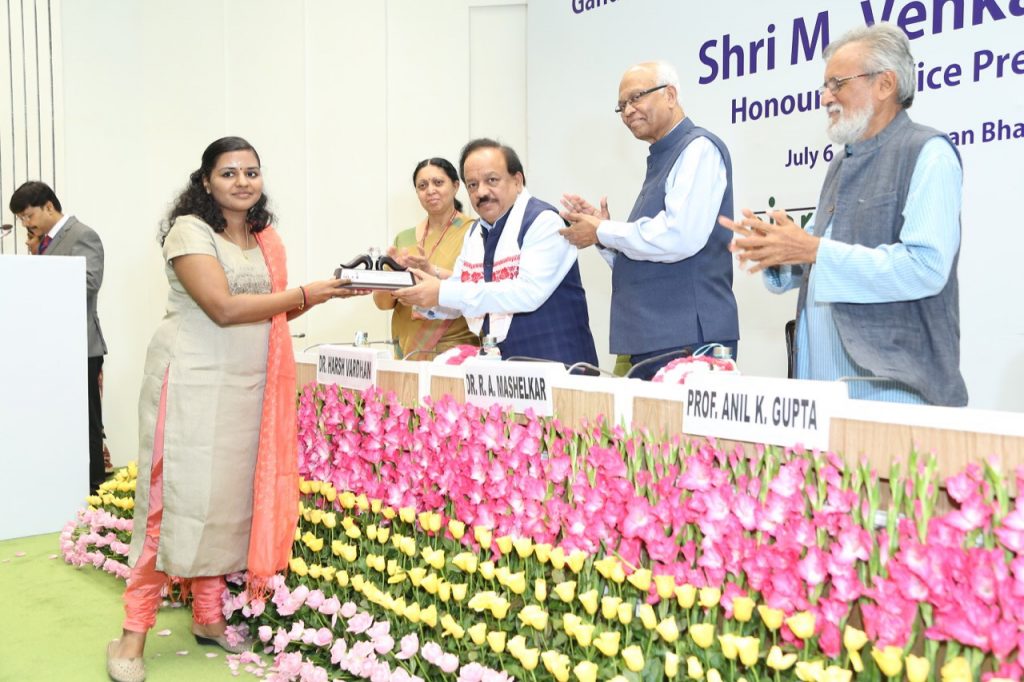Deval Kariav and Rohit Nambiar belong to a new breed to tech innovators who want to make BIRAC-SRISTI-GYTI winning hardware solution for low-cost insulin pump open source. Their vision is that this pump must be affordable and accessible to the poorest diabetic patient in India and the world. Developed under the guidance of Dr Manoj Arora at Indian Institute of Science, Bengaluru, this pump can in future be manufactured at the district level by the small entrepreneur according to the innovator students. Harika Chappa, Avisek Barla, Navin Narayanan, Sudip Chakraborty, and Ahila Yegappan have developed one rupee test strip to identify Mastitis infection in cattle at early. Harika, lead innovator from Sri Venkateswara Veterinary University, Tirupati has some other career plans and is willing to share the entire protocol with anyone who will make it available at an affordable cost. There may be many other GYTOI awardees this year who are willing to make their innovations open source. With excessive stress on only commercially mediated technological change in the society, there is a need for such innovators who wish to expand the public domain and make their solutions available to a large number of distributed social innovators and entrepreneurs at the district level.


Should not there be incentives for such a public-spirited behavior and should we not create a financial window to respect such gestures. The government should create a fund for wider dissemination and translation of such open source technologies and provide tax incentives to such innovator for next five years after their solutions come in the market by third-party entrepreneurs. Social greedless markets matter no less than greed based markets ( I am not passing any moral judgment on those who wish to get financial rewards from their innovation. That is a perfectly legitimate goal. And must be encouraged too. Maybe we should create a pilot manufacturing facility as done by CSIR-CIMAP in Lucknow where small entrepreneurs can manufacture, test for quality control, package their product, and sell it under their brand. If they get a good market, they can think of setting up their own facilities. For a start-up, set up cost fo the tech-innovation based enterprise goes down drastically. If IISC and veterinary university cannot do SRISTI Innovation will provide low-cost fabrication facility to such innovators to ensure that rich technology reaches poor fastest.

Jeethu Raveendran, Amrita Vishwa Vidyapeetham, Coimbatore has developed similar easy to assemble low2 cost open source anemia meter which even a village-level health worker can use and maintain. Preventive health and early stage cure is always extremely democratic and affordable. I hope DBT and BIRAC and may be CSIR/ICMR will consider creating a special fund which will help translation of such ready-to-reach solutions for the poor and honor such innovators by offering them lucrative career options. Should not such a contribution be as important if not more than a publication in a great journal? Most IITs will not hire a young scholar unless she had postdoc experience form a reputed lab abroad. If that results in a disruption in the translation process so it be, or if that solution goes abroad and comes back from that lab back to India, do we really care?
Honorable Vice President of India, Shri M Venkaiah Naidu gave a call for starting an innovation movement in India at the Gandhian Young Technological Innovation award function by SRISTI and Honey Bee Network in cooperation with BIRAC. Union Minister of Science & Technology, Heath and Family Welfare, Dr Harsh Vardhan exhorted young innovators to make their solution available to poorest, particularly in the aspirational districts. DBT secretary Rr Renu Swarup wanted SITARE – Students Innovations for Translation & Advancement of Research Explorations, a BIRAC scheme operated in partnership with Society for Research and Initiatives for Sustainable Technologies and Institutions (SRISTI) to include talented school children also so that we induct youngest explorers in the inclusive innovation Movement. Dr R A Mashelkar, Chair of Steering Committee of SITARE and also SRISTI’s Research Advisory Committee, strongly wanted to make innovation consciousness among common people at grassroots level whether through railway network which has 25 million commuters or through Indian post office which reach all the 650,000 villages through 150,000post offices. In the coming year, we wish to bring students of polytechnic and ITIs also in this ecosystem through GIAN.

The seeds of new inclusive innovation movement are being sown by young people. Innovations for and from grassroots will fuse, blend and compliment the national empathetic ecosystem.
